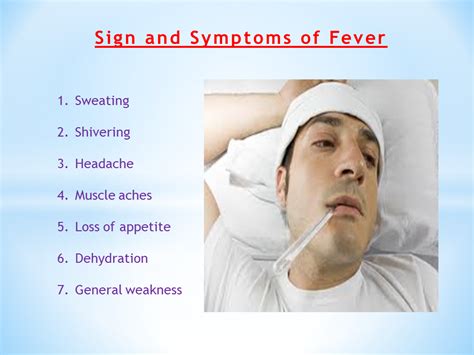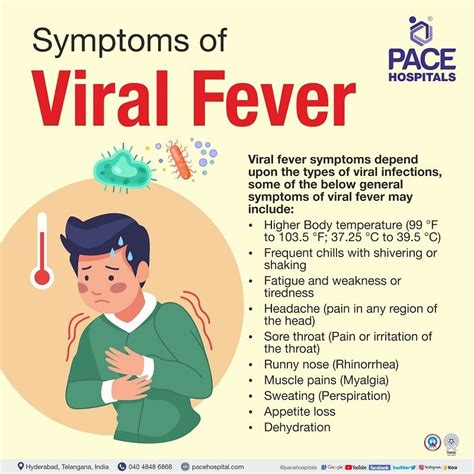Intro
Identify fever symptoms in adults, including high temperature, chills, and sweating. Learn about causes, diagnosis, and treatment options for adult fever, and understand related conditions like infections, inflammation, and immune responses.
Fever is a common symptom that can affect anyone, regardless of age or health status. In adults, fever can be a sign of a minor illness or a more serious condition. It's essential to understand the different types of fever, their causes, and how to manage them effectively. Fever symptoms in adults can vary, and it's crucial to recognize the signs to provide proper care and attention.
When an adult experiences fever, it can be unsettling, especially if it's accompanied by other symptoms such as headache, fatigue, or body aches. Fever can be a natural response of the body's immune system to fight off infections, and in most cases, it resolves on its own with rest, hydration, and over-the-counter medications. However, in some instances, fever can be a sign of a more severe condition, such as pneumonia, meningitis, or sepsis, which requires immediate medical attention.
Understanding fever symptoms in adults is vital to provide timely and effective treatment. Fever can be classified into different types, including low-grade fever, moderate fever, and high fever. Low-grade fever typically ranges from 99°F to 100.4°F, while moderate fever ranges from 100.5°F to 102°F. High fever, on the other hand, is above 103°F and requires immediate medical attention. Recognizing the severity of fever and its accompanying symptoms can help adults take the necessary steps to manage their condition and prevent complications.
Types of Fever

There are several types of fever, each with distinct characteristics and causes. Continuous fever, also known as sustained fever, remains relatively constant over a 24-hour period. Remittent fever, on the other hand, fluctuates throughout the day, but never returns to normal. Intermittent fever occurs in periodic episodes, with the body temperature returning to normal between episodes. Relapsing fever is a type of fever that recurs after a period of normal body temperature. Understanding the type of fever can help healthcare professionals diagnose the underlying cause and provide effective treatment.
Causes of Fever
Fever can be caused by a variety of factors, including infections, inflammatory conditions, and environmental factors. Infections such as pneumonia, meningitis, and sepsis can cause fever, as well as viral infections like influenza and mononucleosis. Inflammatory conditions like rheumatoid arthritis, lupus, and Crohn's disease can also cause fever. Environmental factors such as heat stroke, sunburn, and certain medications can also trigger fever.Recognizing Fever Symptoms

Recognizing fever symptoms in adults is crucial to provide timely and effective treatment. Common symptoms of fever include:
- Elevated body temperature
- Chills
- Sweating
- Headache
- Fatigue
- Muscle aches
- Loss of appetite
- Irritability
- Confusion
In some cases, fever can be accompanied by more severe symptoms, such as:
- Seizures
- Hallucinations
- Difficulty breathing
- Chest pain
- Abdominal pain
- Vomiting
- Diarrhea
Managing Fever
Managing fever involves a combination of self-care measures and medical treatment. Adults with fever can take over-the-counter medications such as acetaminophen or ibuprofen to reduce their body temperature and alleviate symptoms. It's essential to stay hydrated by drinking plenty of fluids, such as water, clear broth, or electrolyte-rich beverages like sports drinks. Resting and avoiding strenuous activities can also help the body recover from the underlying infection.When to Seek Medical Attention

While most cases of fever can be managed at home, there are instances where medical attention is necessary. Adults should seek medical attention if they experience:
- High fever above 103°F
- Severe headache or stiff neck
- Difficulty breathing or chest pain
- Abdominal pain or vomiting
- Seizures or hallucinations
- Fever that lasts for more than 3 days
- Fever that recurs after a period of normal body temperature
Preventing Fever
Preventing fever involves taking measures to reduce the risk of infection and maintaining a healthy lifestyle. Practicing good hygiene, such as washing hands frequently, can help prevent the spread of infections. Getting vaccinated against flu and other diseases can also reduce the risk of fever. Maintaining a healthy diet, exercising regularly, and getting enough sleep can help boost the immune system and prevent fever.Treatment Options

Treatment options for fever depend on the underlying cause and severity of the condition. Over-the-counter medications such as acetaminophen or ibuprofen can help reduce body temperature and alleviate symptoms. In some cases, antibiotics may be prescribed to treat bacterial infections. Antiviral medications may be prescribed to treat viral infections such as influenza. In severe cases, hospitalization may be necessary to provide supportive care and monitor the patient's condition.
Home Remedies
There are several home remedies that can help alleviate fever symptoms. Taking a cool bath or using a cool compress can help reduce body temperature. Drinking plenty of fluids, such as water, clear broth, or electrolyte-rich beverages, can help stay hydrated. Resting and avoiding strenuous activities can also help the body recover from the underlying infection. Using a humidifier to add moisture to the air can help relieve congestion and cough.Complications of Fever

Fever can lead to several complications, especially if left untreated or if the underlying cause is severe. Dehydration can occur if the body loses too much fluid due to sweating, vomiting, or diarrhea. Seizures can occur in severe cases of fever, especially in children. Brain damage can occur if the body temperature rises too high, causing damage to the brain tissue. Organ failure can occur in severe cases of fever, especially if the underlying cause is a severe infection.
Long-term Effects of Fever
The long-term effects of fever depend on the underlying cause and severity of the condition. In most cases, fever resolves on its own without any long-term effects. However, in some cases, fever can lead to long-term complications, such as brain damage, organ failure, or permanent disability. It's essential to seek medical attention if fever persists or recurs, as this can indicate a more severe underlying condition.What is the normal body temperature for adults?
+Normal body temperature for adults ranges from 97.7°F to 99.5°F.
How can I reduce my fever at home?
+You can reduce your fever at home by taking over-the-counter medications such as acetaminophen or ibuprofen, staying hydrated, and resting.
When should I seek medical attention for fever?
+You should seek medical attention if your fever is above 103°F, if you experience severe symptoms such as difficulty breathing or chest pain, or if your fever lasts for more than 3 days.
In conclusion, fever symptoms in adults can vary, and it's essential to recognize the signs to provide proper care and attention. Understanding the different types of fever, their causes, and how to manage them effectively can help adults take the necessary steps to prevent complications and promote recovery. By staying informed and taking proactive measures, adults can reduce their risk of fever and maintain overall health and well-being. We invite you to share your thoughts and experiences with fever symptoms in adults in the comments section below. If you found this article informative, please share it with your friends and family to help raise awareness about fever symptoms and their management.
